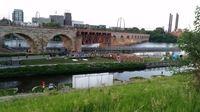Weather Report: Structuring Data Experience in the Built Environment

With the influx of data into the everyday, users demand an interactivity that is localized and immediate, connected to and informed by exhaustive information across space, time, and discipline. As the data cloud burgeons through a plethora of types of inputs, designers grapple with frameworks for analysis and visualization, and the experience of interacting with information remains visually strapped to surfaces of digital display or pre-set as largely static objects. As the Internet of Things develops and the built environment becomes sensing and automated, the ability for all people to engage with, understand, and have a role in the complexity of data input and output requires a new paradigm for building, one in which data is an intelligible component of an environment that is continual, receptive, and communicative.
This paper analyzes Weather Report, a constructed environment driven by user-informed data collaboratively designed by an interdisciplinary group of architects, landscape architects, and computer scientists. The aim of this paper is to discuss the assets and liabilities of a spatial data experience posed by the project, framed through questions of design agency related to data input, user interaction, a plurality of design voices, and the implications of this innovative approach on broader practices. It suggests that a field termed “spatio-data design” might be an emergent area of study, where the built environment is as informed by the management and choreography of data as it is by the traditional assembly of physical materials and components.
keywords: data visualization, mixed computer and human data, spatio-data design, interdisciplinary design collaboration, design agency


Add comment
Log in to post comments